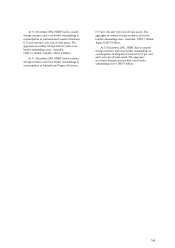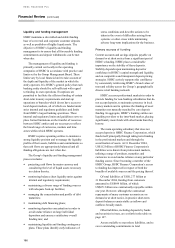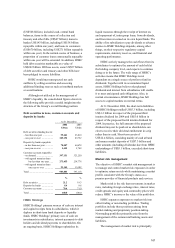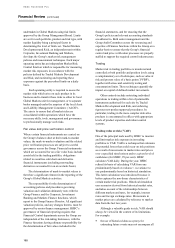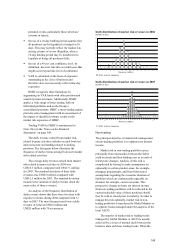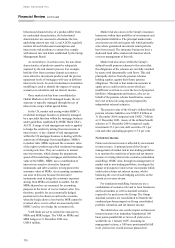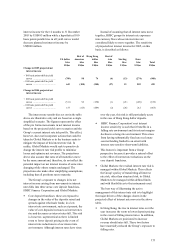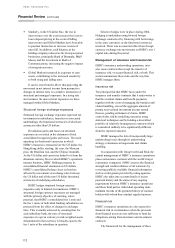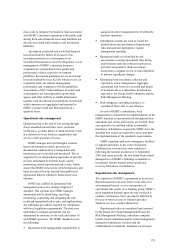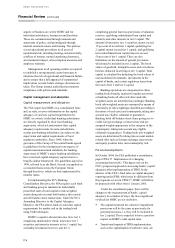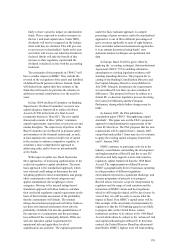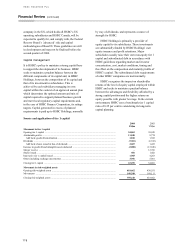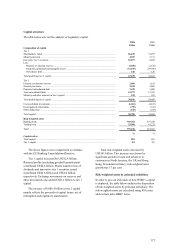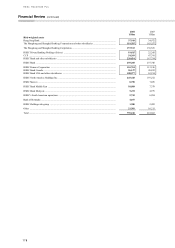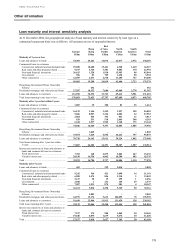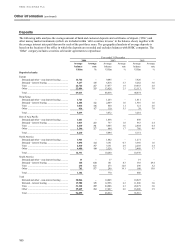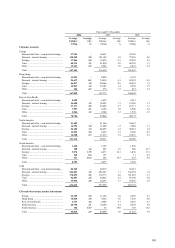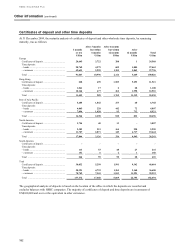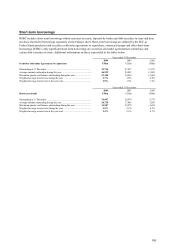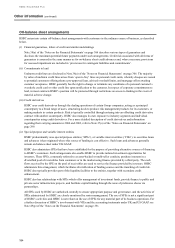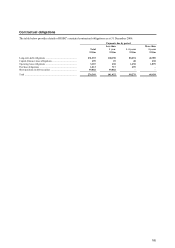HSBC 2004 Annual Report Download - page 177
Download and view the complete annual report
Please find page 177 of the 2004 HSBC annual report below. You can navigate through the pages in the report by either clicking on the pages listed below, or by using the keyword search tool below to find specific information within the annual report.175
likely to have a positive impact on shareholders’
funds. This is expected to result in increases in
the tier 1 and total capital ratios. Under IFRS,
dividends will not be recognised on the balance
sheet until they are declared. This will give rise
to an increase in shareholders’ funds at the year-
end which will reverse out when the dividend is
declared. Banks will take the benefit of this
increase to their regulatory capital until the
dividend is declared, in line with the accounting
treatment.
The remainder of the proposals in CP04/17 will
have a smaller impact on HSBC. They include the
reversal of the recognition of the assets and liabilities
of defined benefit pension schemes. Instead, banks
will deduct from capital their best estimate of the
funds that will need to be paid into the schemes in
addition to normal contributions over the next five
years.
In June 2004, the Basel Committee on Banking
Supervision (‘the Basel Committee’ ) issued a new
capital adequacy framework to replace the Basel
Accord of 1988 in the form of a final Accord
(commonly known as ‘Basel II’ ). The new capital
framework consists of three ‘pillars’ : minimum
capital requirements, supervisory review process and
market discipline. The supervisory objectives of the
Basel Committee are for Basel II to promote safety
and soundness in the financial system and, as such,
at least maintain the current overall level of capital
in the system; to enhance competitive equality; to
constitute a more comprehensive approach to
addressing risks; and to focus on internationally
active banks.
With respect to pillar one, Basel II provides
three approaches, of increasing sophistication, to the
credit risk regulatory capital calculation. The most
basic approach is the standardised approach, which
uses external credit ratings to determine the risk
weighting applied to rated counterparties and groups
other counterparties into broad categories and
applies standardised risk weightings to these
categories. Moving to the internal ratings based
foundation approach will allow banks to calculate
their credit risk regulatory capital requirement on the
basis of their internal assessment of the probability
that the counterparty will default. The internal
ratings-based advanced approach will allow banks to
use their own internal assessment of not only the
probability of default, but also the quantification of
the exposure to a counterparty and the percentage
loss suffered if the counterparty defaults. Pillar one
will also introduce capital requirements for
operational risk and again three levels of
sophistication are available. The capital requirement
under the basic indicator approach is a simple
percentage of gross revenues; under the standardised
approach it is one of three different percentages of
gross revenues applicable to each of eight business
lines; and under advanced measurement approaches
it is an amount determined using banks’ own
statistical analysis techniques on operational risk
data.
In Europe, Basel II will be given effect by
applying the ‘re-casting technique’ (Interinstitutional
Agreement 2002/C 77/01) enabling substantive
amendments to existing legislation without a self-
standing amending directive. The proposal for re-
casting of the Banking Consolidation Directive and
the Capital Adequacy Directive was published in
July 2004. It largely incorporates the requirements
set out in Basel II, but there are also a number of
differences. This proposal will now be subject to a
formal EU co-decision legislative process involving
the Council of Ministers and the European
Parliament, during which further changes may be
made.
In January 2005, the FSA published a
consultation paper CP05/3 ‘Strengthening capital
standards’ . This paper sets out the FSA’ s proposed
approach to implementing the requirements of the
recast EU directives. The FSA proposes that the new
requirements will be applied from 1 January 2007,
except that under pillar 1 firms may elect to continue
to apply the existing capital adequacy framework
until 1 January 2008.
HSBC continues to participate actively in the
industry consultations surrounding the development
and implementation of Basel II and the re-cast EU
directives and fully supports a more risk-sensitive
regulatory capital framework than the 1988 Basel
Accord. The implementation of Basel II across
HSBC’ s geographically diverse businesses operating
in a large number of different regulatory
environments represents a significant challenge, and
a major programme of projects is in progress.
Basel II allows extensive scope for interpretation by
regulators and the range of such variation and the
interaction of HSBC’ s home and host regulators,
which is still being developed, will be key factors. In
view of this, it is still too early to assess what the
impact of Basel II on HSBC’ s capital ratios will be.
One example of the uncertainty in interpretation by
regulators is that the US banking agencies are likely
to propose that, in the United States, certain
institutions continue to be subject to the 1988 Basel
Accord while others be subject to the ‘advanced’ risk
and capital methodologies of Basel II. In this latter
context, the Federal Reserve Board has determined
that HNAH, HSBC’ s highest level US bank holding


